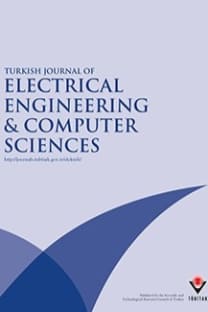Simulation of discrete electromagnetic propagation model for atmospheric effects on mobile communication
Propagation, atmospheric effects, mobile communication, simulation
Simulation of discrete electromagnetic propagation model for atmospheric effects on mobile communication
Propagation, atmospheric effects, mobile communication, simulation,
___
- International Telecommunication Union, ITU-R Recommendations 838, Specific Attenuation Model for Use in Prediction Method, Propagation in Non-Ionized Media, Geneva, ITU, 1994.
- R.K. Crane, Electromagnetic Wave Propagation through Rain, New York, Wiley Interscience, 1996.
- M.F. Iskander, Z. Yun, “Propagation prediction models for wireless communication systems”, IEEE Transactions on Microwave Theory, Vol. 50, pp. 662–673, 2002.
- R.H. Lang, S.S. Seker, D.M. LeVine, “Vector solution for the mean electromagnetic fields in a layer of random particles”, Radio Science, Vol. 21, pp. 771–786, 1986.
- L.J. Ippolito, Propagation Effects Handbook for Satellite Systems Design, 3rd ed., Ashburn, VA, USA, Stanford Telecom ACS, 1999.
- International Telecommunication Union, ITU-R Recommendations, Attenuation Due to Clouds and Fog, pp. 840-3, Geneva, ITU, 1994.
- A. Dissanayake, J. Allnutt, F. Haidara, “Cloud attenuation modeling for SHF and EHF applications”, International Journal of Satellite Communication, Vol. 19, pp. 335–345, 2001.
- J.S. Ojo, M.O. Ajewole, S.K. Sarkar, “Rain rate and rain attenuation prediction for satellite communication in Ku and Ka bands over Nigeria”, Progress in Electromagnetics Research B, Vol. 5, pp. 207–223, 2008.
- A.R. Holt, R.J. Rummings, G.J.G. Upton, W.J. Bradford, “Rain rates, drop size information and precipitation type, obtained from one-way differential propagation phase and attenuation along a microwave link”, Radio Science, Vol. 43, RS5009-18, 2008.
- M.A. Fares, S.C. Fares, C.A. Ventrice, “Attenuation of the electromagnetic waves due to moist and wet snow”, Proceedings of the IEEE Southeast Con, pp. 99–104, 2007.
- M.S. Awan, P. Brandl, E. Leitgeb, F. Nadeem, L. Csugai-Horvath, R. Nebuloni, “Transmission of high data rate optical signals in fog and snow conditions”, Wireless Vitae, pp. 702–706, 2009.
- A. Ishimaru, Wave Propagation and Scattering in Random Media, London, UK, Academic Press, 1978.
- S.S. Seker, “Radar cross-section of thin dielectric bodies”, IEE Proceedings Part H, Vol. 4, pp. 305–307, 1986. R.M. Rasmussen, J. Vivekanandan, J. Cole, B. Myers, C. Masters, “The estimation of snowfall rate using visibility”, Journal of Applied Meteorology, Vol. 38, pp. 1542–1563, 1999.
- T. Tjelta, D. Bacon, “Predicting combined rain and wet snow attenuation on terrestrial links”, IEEE Transactions on Antenna and Propagation, Vol. 58, pp. 1677–1682, 2010.
- C. Magono, C.W. Lee, “Meteorological classification of natural snow crystals”, Journal of Faculty Science, Hokkaido University, Japan, Series VII, Vol. 2, pp. 321–335, 1966.
- J.R. Cesar, D. Bello, L. Gl´ aucio, H.L. Bertoni, “Theoretical analysis and measurement results of vegetation effects on path loss for mobile cellular communication systems”, IEEE Transactions on Vehicular Technology, Vol. 49, pp. 1285–1292, 2000.
- S.S. Seker, F.C. Kunter, “Multi-components mobile propagation model of park environment”, IEEE Transaction on Magnetics, Vol. 47, pp. 1494–1497, 2011.
- S.S. Seker, “Multi-components discrete propagation model of forest”, IEE Proceedings Part H, Vol. 142, pp. 201–206, 19
- ISSN: 1300-0632
- Yayın Aralığı: Yılda 6 Sayı
- Yayıncı: TÜBİTAK
Adaptive detection of chaotic oscillations in ferroresonance using modified extended Kalman filter
Cengiz Polat UZUNOĞLU, Mukden UĞUR
Multireference TDOA-based source localization
Hamid Torbati FARD, Mahmoud ATASHBAR, Yaser NOROUZI, Farrokh Hojjat KASHANI
Aydan ÇELEBİLER, Hüseyin ŞEKER, Bora YÜKSEL, Ahmet ORUN
A new method based on sensitivity analysis to optimize the placement of SSSCs
Hamed HASHEMI-DEZAKI, Masoud MOHAMMADALIZADEH-SHABESTARY
Feyzi AKAR, Yıldıray YALMAN, Hüseyin Selçuk VAROL
Musa PEKER, Baha ŞEN, Pınar Yıldız KUMRU
Afshin Lashkar ARA, Ahad KAZEMI, Mohammad BEHSHAD
Comparison of speech parameterization techniques for the classification of speech disfluencies
Chong Yen FOOK, Hariharan MUTHUSAMY, Lim Sin CHEE, Sazali Bin YAACOB, Abdul Hamid Bin ADOM
